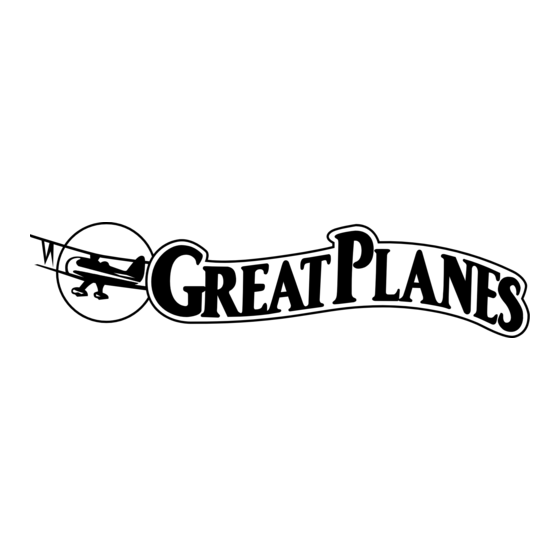GREAT PLANES Slinger GPMA1180 Gebruiksaanwijzing - Pagina 10
Blader online of download pdf Gebruiksaanwijzing voor {categorie_naam} GREAT PLANES Slinger GPMA1180. GREAT PLANES Slinger GPMA1180 12 pagina's. Speed 400 electric fun fly arf

3. If additional weight is required to balance the model,
use small pieces of Great Planes stick-on weight
(GPMQ4485). If weight is required in the tail, it can be stuck
to the top of the wing next to the motor. If weight is required
in the nose, a slot can be cut in the nose where the weight
can be inserted. The slot can then be covered with tape. Our
prototype model required 1 oz. of weight on the nose.
4. After placing weight on the model where necessary,
recheck the C.G. to confirm that it is correct.
Identify your Model
No matter if you fly at an AMA sanctioned R/C club site or if
you fly somewhere on your own, you should always have
your name, address, telephone number and AMA number
on or inside your model. It is required at all AMA R/C club
flying sites and AMA sanctioned flying events. Photocopy
and fill out the identification tag on the last page and place
it on or inside your model.
Charge the Transmitter Batteries
Be certain the transmitter batteries are fully charged. Follow
the battery charging instructions that came with your radio
control system to charge the batteries.
Ground Inspection
Before you fly you should perform one last overall inspection to
make sure the model is truly ready to fly and that you haven't
overlooked anything. If you are not thoroughly familiar with the
operation of R/C models, ask an experienced modeler to
perform the inspection. Check to see that you have the radio
installed correctly and that all the controls are connected
properly. The motor must also be checked by confirming that
the prop is rotating in the correct direction and the motor
sounds like it is reaching full power. Make certain the ailevators
are secure, the pushrods are connected, the controls respond
in the correct direction, radio components are securely
mounted, and the C.G. is correct.
Range Check
Ground check the operational range of your radio before the
first flight of the day. With the transmitter antenna collapsed
and the receiver and transmitter on, you should be able to
walk at least 100 feet away from the model and still have
control. Have an assistant stand by your model and, while
you work the controls, tell you what the control surfaces are
doing. Repeat this test with the motor running at various
speeds with an assistant holding the model, using hand
signals to show you what is happening. If the control
surfaces do not respond correctly, do not fly! Find and
correct the problem first. Look for loose servo connections
or broken wires, corroded wires on old servo connectors,
poor solder joints in your battery pack or a defective cell, or
a damaged receiver crystal from a previous crash.
Performance Tips
Use fine sandpaper to remove imperfections along the
edges of the propeller. For the best performance, use a Top
Flite Precision Magnetic Prop Balancer™ (TOPQ5700) to
balance the propellers (this is a necessity on glow-powered
engines, and should be done with electric models as well).
Using multiple battery packs for successive flights may
cause the motor to become excessively hot, thus causing
damage. Allow the motor to cool for at least 10 minutes
between flights.
Motor Safety Precautions
Failure to follow these safety precautions may result in
severe injury to yourself and others.
Get help from an experienced pilot when learning to
operate motors.
Use safety glasses when running motors.
Do not run the motor in an area of loose gravel or sand; the
propeller may throw such material in your face or eyes.
Keep your face and body as well as all spectators away from
the path of the propeller as you start and run the motor.
Keep items such as these away from the prop: loose
clothing, shirt sleeves, ties, scarfs, long hair or loose objects
(pencils, screw drivers) that may fall out of shirt or jacket
pockets into the prop.
10
